Per impostazione predefinita, WordPress visualizza i tuoi post del blog nella home page. Tuttavia, se stai creando un sito web aziendale o semplicemente desideri personalizzare la tua home page, potresti volere una pagina separata per la sezione del tuo blog.
Questa configurazione non solo ti aiuta a mantenere la tua home page pulita e focalizzata, ma fornisce anche uno spazio dedicato ai lettori per esplorare i contenuti del tuo blog.
Per migliorare l'esperienza utente e mantenere un chiaro focus sulle nostre offerte, abbiamo aggiunto pagine blog separate su molti dei siti web delle nostre aziende partner, tra cui WPForms, OptinMonster e All in One SEO. Ciò consente ai visitatori di accedere facilmente ai contenuti del blog, dando priorità all'obiettivo principale di promuovere i nostri plugin.
In questo articolo, ti mostreremo due modi per creare una pagina separata per i post del blog in WordPress.
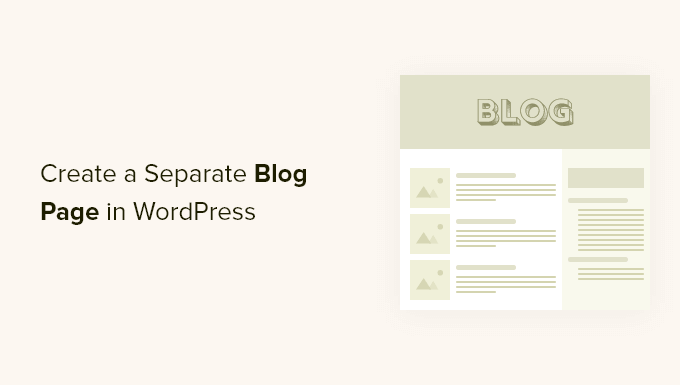
Perché visualizzare i post del blog su una pagina separata?
La home page è la pagina principale del tuo sito web WordPress e la prima pagina che i tuoi visitatori vedono. Per impostazione predefinita, WordPress mostra i tuoi post più recenti sulla tua home page, e questo ha senso se stai gestendo un blog.
Ma non è sempre l'ideale per siti web di piccole imprese. Probabilmente vorrai una home page più coinvolgente che informi gli utenti sulla tua attività, sui prodotti e sui servizi, faccia sapere loro come contattarti e aumenti la conversione delle tue vendite.
Ora, se desideri anche gestire un blog sul tuo sito web, dovrai fornire un'altra pagina dove i visitatori potranno leggere i tuoi post.
Detto questo, ti mostreremo come creare facilmente una pagina separata per i post del blog in WordPress.
In questo tutorial, abbiamo discusso due metodi e puoi usare i link qui sotto per passare al metodo di tua scelta. Tieni presente che il secondo metodo è il più semplice e offre la massima personalizzazione:
- Metodo 1: Creare Pagine Separate per i Post del Blog in WordPress
- Metodo 2: Creare una Pagina Personalizzata per i Post del Blog con un Costruttore Drag & Drop (Consigliato)
- Bonus: Visualizzare i Tuoi Post Recenti in WordPress
Tutorial video
Se preferisci istruzioni scritte, continua a leggere.
Metodo 1: Creare Pagine Separate per i Post del Blog in WordPress
Puoi creare una pagina separata per i post del blog utilizzando le impostazioni predefinite di WordPress.
Tuttavia, questo metodo richiede un po' più di lavoro rispetto al Metodo 2 e non offre tante opzioni di personalizzazione.
Creare una Pagina Principale e una Pagina del Blog Separate
Innanzitutto, devi creare due pagine WordPress separate da utilizzare come pagina principale e pagina del blog.
Non è necessario aggiungere alcun contenuto a queste pagine e puoi nominarle come preferisci. Ad esempio, alcuni siti web aziendali usano 'Notizie' per la loro pagina del blog.
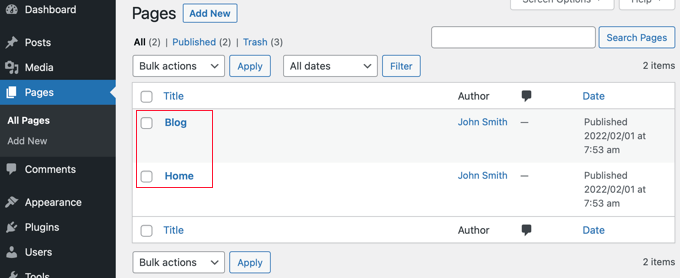
Una volta create queste pagine, visita la pagina Impostazioni » Lettura nell'area di amministrazione di WordPress.
Ora, nella sezione etichettata 'La tua homepage visualizza', devi fare clic sul pulsante 'Una pagina statica'.
Successivamente, puoi selezionare le pagine Home e Blog che hai creato in precedenza. Dovresti quindi scorrere verso il basso e fare clic sul pulsante 'Salva modifiche'.

Ora, quando navighi nella schermata Pagine » Tutte le Pagine dalla dashboard di WordPress, vedrai che la pagina Home è etichettata come 'Pagina principale' e la pagina Blog è etichettata come 'Pagina post'.
Vai avanti e fai clic sul link 'Visualizza' sotto la pagina Blog per visualizzarla in anteprima.
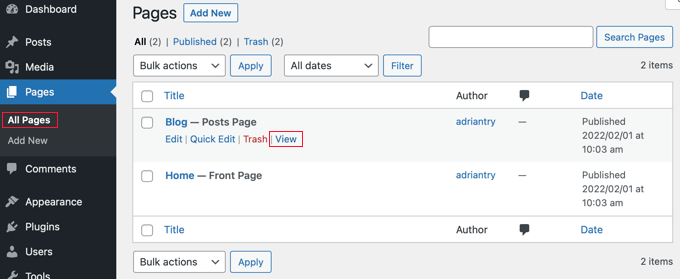
L'aspetto di queste pagine dipende dal tuo tema WordPress e potresti voler configurare queste impostazioni.
Ad esempio, se il tuo tema ha un menu di navigazione, noterai che WordPress ha aggiunto automaticamente le nuove pagine Blog e Home. In caso contrario, consulta la nostra guida per principianti su come aggiungere un menu di navigazione in WordPress.
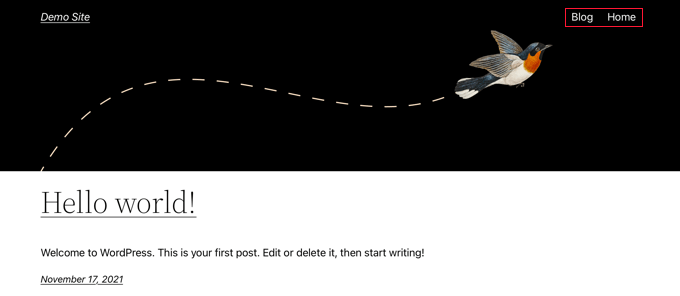
Personalizzazione della tua Home Page
Finora, la tua nuova home page è vuota. Ora è il momento di aggiungere informazioni sulla tua attività, sui tuoi prodotti e servizi e far sapere ai tuoi visitatori come possono contattarti.
Puoi imparare come farlo nella nostra guida su come creare una home page personalizzata in WordPress. Nel Metodo 1, ti mostriamo come utilizzare l'editor a blocchi per aggiungere immagini di copertina, colonne, tabelle, testo e media, gallerie e altro ancora.
Troverai anche molte idee di personalizzazione creative nella nostra guida su come modificare una home page di WordPress in modo facile ed efficace.
Personalizzazione della tua pagina blog
Se sei soddisfatto dell'aspetto della tua pagina blog, allora il tuo lavoro è finito.
Tuttavia, se stai attualmente utilizzando un tema basato su blocchi, puoi anche personalizzare la tua pagina blog visitando la schermata Aspetto » Editor dalla dashboard di WordPress.
Una volta lì, seleziona l'opzione 'Pagine' dalla colonna di sinistra nell'editor completo del sito.
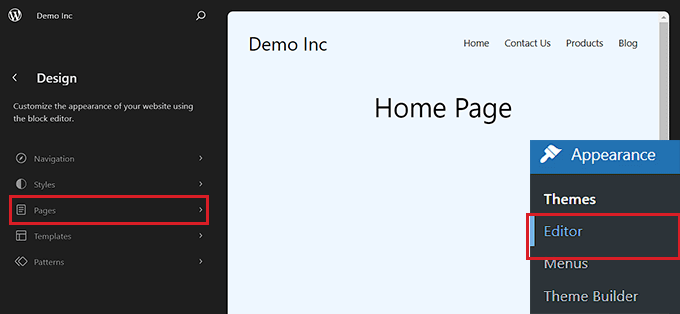
Questo aprirà un elenco di tutte le pagine del tuo sito web nella colonna di sinistra.
Da qui, seleziona l'opzione della pagina 'Blog' e quindi fai clic sull'anteprima della pagina sulla destra per iniziare a personalizzare la tua pagina blog.
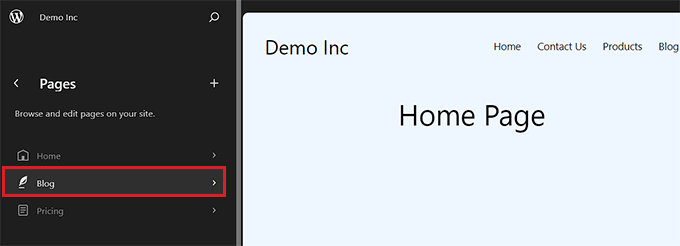
Ora puoi fare clic sul pulsante '+' per aggiungere blocchi nell'angolo in alto a sinistra dello schermo e aggiungere blocchi a tua scelta alla pagina.
Inoltre, puoi cambiare il colore di sfondo, del testo o dei link sulla tua pagina blog facendo clic sull'icona 'Stili' nell'angolo in alto a destra dello schermo.
Questo aprirà un pannello di blocchi sulla destra da cui puoi fare clic sulla scheda 'Tipografia' per cambiare il colore del testo, sulla scheda 'Colori' per cambiare il colore di sfondo e sulla scheda 'Layout' per configurare le dimensioni della tua pagina blog.
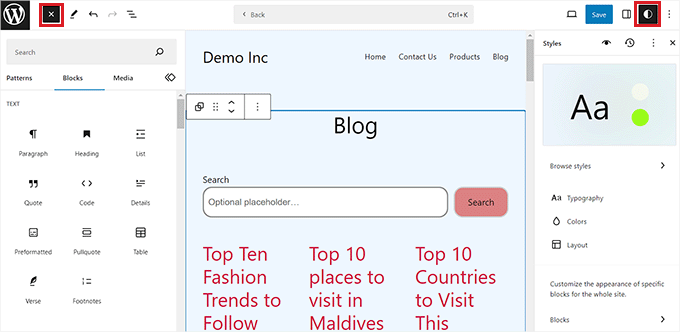
Una volta terminato, non dimenticare di fare clic sul pulsante 'Salva' in alto per archiviare le tue impostazioni.
Ora puoi visitare la tua pagina blog di WordPress per vedere come appare.
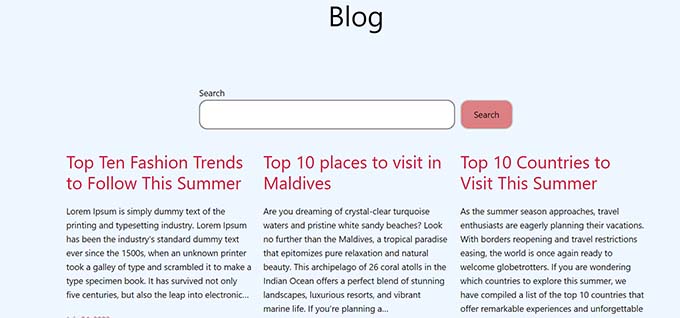
Tuttavia, se stai utilizzando un tema classico, dovrai utilizzare il Metodo 2 per personalizzare la pagina dei tuoi post del blog.
Metodo 2: Creare una Pagina Personalizzata per i Post del Blog con un Costruttore Drag & Drop (Consigliato)
Un plugin per la creazione di temi ti consente di creare facilmente un tema WordPress personalizzato senza alcun codice. Ciò include la possibilità di creare e personalizzare una pagina separata per i post del blog.
Installazione del SeedProd Theme Builder
Innanzitutto, devi installare e attivare il plugin SeedProd. Per maggiori dettagli, consulta la nostra guida passo passo su come installare un plugin WordPress.
SeedProd è il miglior page builder drag-and-drop per WordPress per aziende, blogger e proprietari di siti web. Ha anche un designer di temi che ti consente di personalizzare facilmente la tua pagina del blog e molto altro.
Puoi leggere la nostra recensione completa di SeedProd per maggiori dettagli.
Dopo l'attivazione, visita la pagina SeedProd » Impostazioni per inserire la tua chiave di licenza. Puoi trovare queste informazioni nel tuo account sul sito web di SeedProd.

Dopodiché, è ora di creare un tema WordPress personalizzato. È molto più semplice di quanto sembri.
Creazione di un tema WordPress personalizzato
Innanzitutto, devi visitare la pagina SeedProd » Theme Builder. Qui, utilizzerai uno dei temi predefiniti di SeedProd come punto di partenza. Questo sostituirà il tuo tema WordPress esistente con un nuovo design personalizzato.
Puoi farlo cliccando sul pulsante 'Temi'.
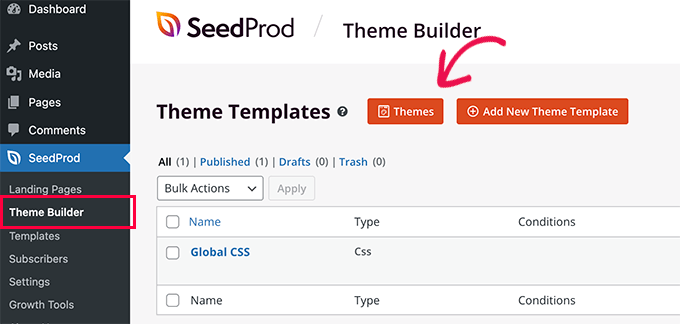
Ora ti verrà mostrato un elenco di temi progettati professionalmente che sono pensati per diversi tipi di siti web.
Ad esempio, ci sono modelli chiamati 'Modern Business', 'Marketing Agency' e 'Mortgage Broker Theme'.
Dai un'occhiata alle opzioni e seleziona quella che meglio si adatta alle tue esigenze facendo clic sull'icona del segno di spunta.
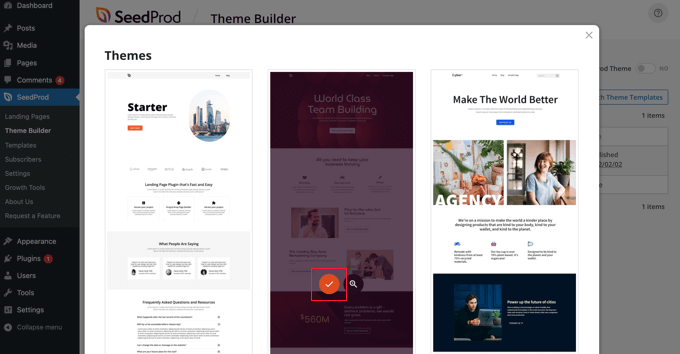
Una volta scelto un tema, SeedProd genererà tutti i modelli del tema, incluso uno per l'indice del tuo blog e uno per la tua home page.
Queste non sono solo pagine vuote, ma vengono fornite con layout accattivanti e contenuti segnaposto facili da personalizzare.
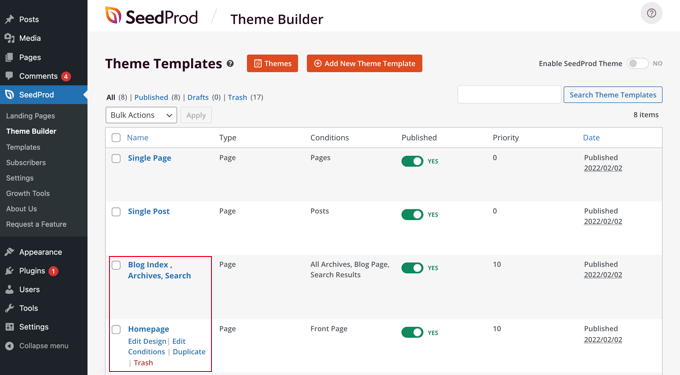
In questo tutorial, ti mostreremo come personalizzare i modelli della home page e dell'indice del blog.
Potresti anche voler personalizzare gli altri modelli. Per sapere come farlo, consulta la nostra guida per principianti su come creare facilmente un tema WordPress personalizzato.
Personalizzazione della tua Home Page
Una volta generati i modelli del tuo tema, puoi modificarli utilizzando il generatore di temi SeedProd. Inizieremo con il modello della Homepage.
Fai semplicemente clic sul link ‘Modifica Design’ sotto la homepage per iniziare.

Questo aprirà il file del modello nel generatore di temi SeedProd.
Questo semplice generatore drag-and-drop mostrerà un'anteprima live della tua pagina sulla destra e una barra degli strumenti dei blocchi sulla sinistra.
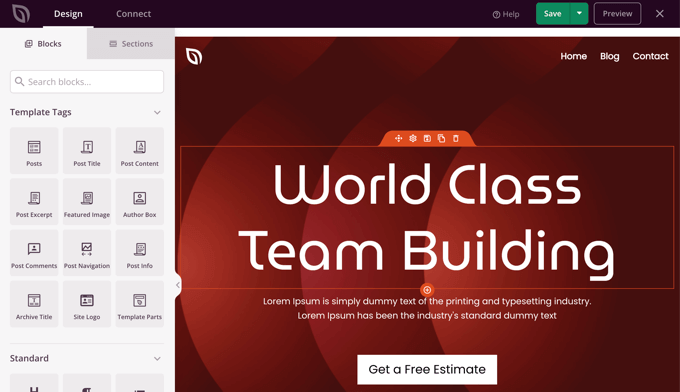
Puoi personalizzare qualsiasi blocco facendo clic su di esso, trascinando i blocchi su e giù con il mouse e aggiungendo nuovi blocchi alla pagina.
Abbiamo scritto una guida completa su come creare una homepage personalizzata in WordPress. Scorri semplicemente verso il basso fino al Metodo 2 per scoprire come personalizzare la tua homepage utilizzando SeedProd.
Personalizzazione della tua pagina blog
Il costruttore di temi SeedProd offre anche molti modi per personalizzare la tua pagina indice del blog.
Inizia facendo clic sul link ‘Modifica Design’ sotto la pagina.

Vedrai lo stesso riquadro di anteprima sulla destra e la barra degli strumenti sulla sinistra. Puoi personalizzare la pagina del blog nello stesso modo in cui hai fatto con la home page.
Ad esempio, quando fai clic sull'intestazione, potrai vedere tutte le sue impostazioni. Puoi modificare il testo, cambiare l'allineamento e la dimensione del carattere, e altro ancora.
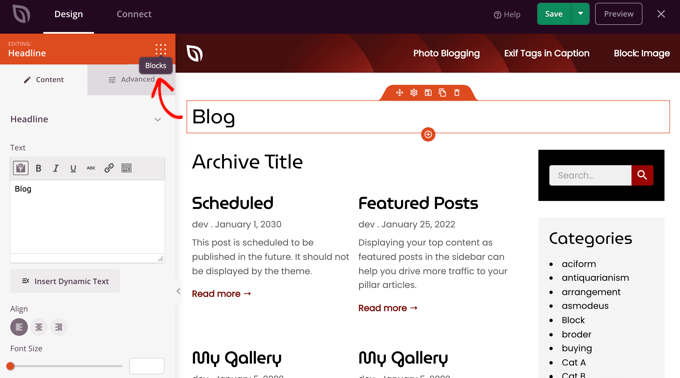
Una volta terminato, dovrai fare clic sull'icona ‘Blocchi’ per tornare alla barra degli strumenti.
Il costruttore di temi SeedProd offre blocchi aggiuntivi di Parti del modello, come un blocco Post, che visualizza un elenco dei tuoi post del blog.
Il blocco Post è già stato aggiunto al modello indice del blog per te e, in questo modello, il blocco visualizza i tuoi post in due colonne. Possiamo cambiarlo in una singola colonna.
Fai semplicemente clic sul blocco Post e quindi cambia l'impostazione ‘Colonne’ in 1.
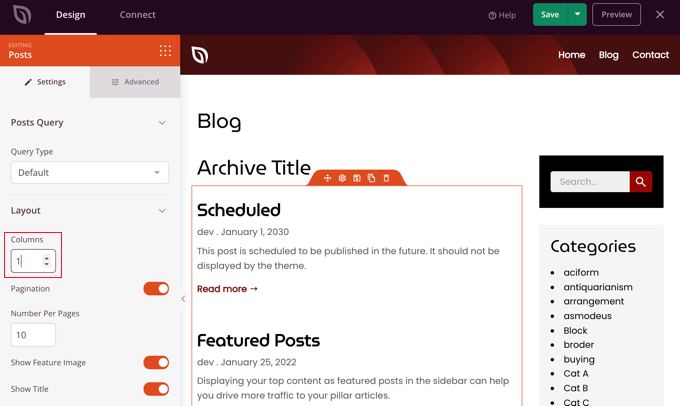
Il layout cambierà immediatamente in una singola colonna.
Scorrendo verso il basso le impostazioni del blocco Post, troverai interruttori che ti permettono di scegliere se visualizzare o meno l'immagine in evidenza e il titolo del post. Puoi anche scegliere quale tag di intestazione utilizzare per il titolo del post.
Ci sono anche opzioni per visualizzare diversi metadati del post. Puoi attivare la data di modifica, l'autore, la data e l'ora di pubblicazione e il conteggio dei commenti.
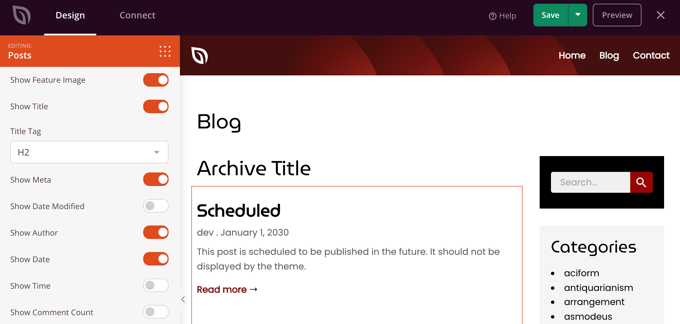
Ecco alcuni altri modi per personalizzare il tuo indice del blog:
- Puoi filtrare l'indice per tipo di post, categoria, tag o autore.
- L'ordine di ordinamento dei post può essere modificato.
- Puoi scegliere quanti post vengono visualizzati in una pagina.
- Puoi attivare l'estratto del post e personalizzarne la lunghezza.
Una volta terminata la personalizzazione della tua pagina del blog, assicurati di fare clic sul pulsante ‘Salva’ in cima allo schermo. Quindi, puoi tornare all'elenco dei modelli facendo clic sull'icona ‘X’.
Abilitare il tema SeedProd
Una volta terminata la personalizzazione dei modelli del tema, dovrai pubblicare il nuovo tema personalizzato.
Basta attivare l'impostazione ‘Abilita tema SeedProd’ sulla posizione ‘SÌ’.
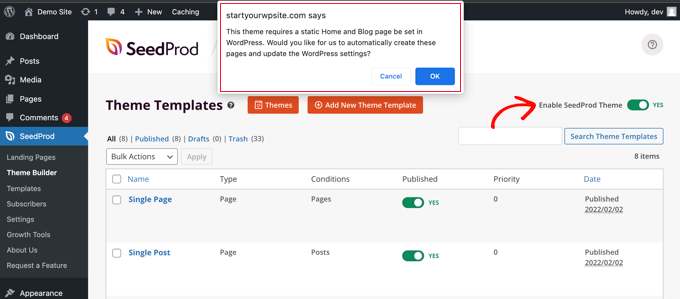
Vedrai immediatamente una notifica che le impostazioni della Home page e della pagina del blog di WordPress devono essere modificate. Facendo clic sul pulsante ‘OK’, queste impostazioni verranno modificate per te.
Ora puoi visitare il tuo sito web per visualizzare la tua nuova home page e la pagina del blog. Questo è l'aspetto della pagina indice del blog sul nostro sito demo.
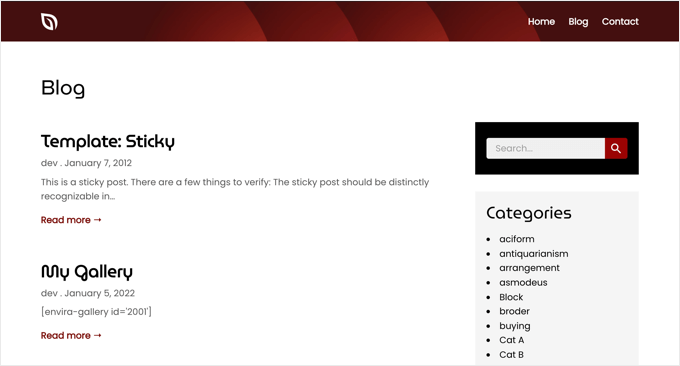
Bonus: Visualizzare i Tuoi Post Recenti in WordPress
Una volta creata una pagina separata per il blog, puoi comunque mostrare alcuni post recenti sulla tua home page per incoraggiare gli utenti a esplorare ulteriormente il tuo sito.
Per fare ciò, apri la tua home page nell'editor a blocchi di WordPress. Una volta lì, fai clic sul pulsante ‘Aggiungi blocco’ nell'angolo in alto a sinistra dello schermo per aprire il menu dei blocchi.
Da qui, aggiungi semplicemente il blocco ‘Ultimi post’ alla pagina. Una volta fatto ciò, puoi personalizzare l'elenco dei post recenti per visualizzare gli estratti dei post, i nomi degli autori e le date secondo le tue preferenze.
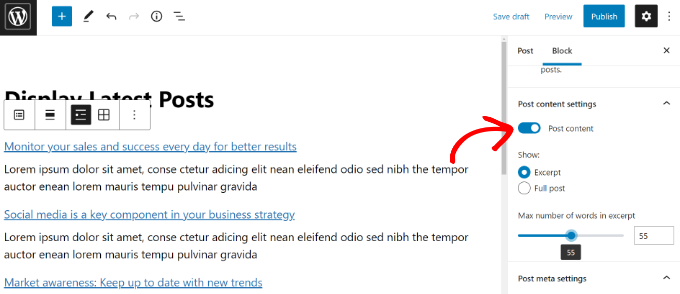
Infine, fai clic sul pulsante ‘Pubblica’ in alto per salvare le tue impostazioni. Ora, alcuni dei tuoi post recenti verranno ancora visualizzati sulla home page per garantire che gli utenti trascorrano più tempo sul tuo sito web.
Per maggiori informazioni, puoi consultare il nostro tutorial su come visualizzare i post recenti in WordPress.
Speriamo che questo tutorial ti abbia aiutato a imparare come creare una pagina separata per i post del blog in WordPress. Potresti anche voler imparare come aggiungere uno stato personalizzato dei post per i post del blog in WordPress o dare un'occhiata al nostro elenco dei migliori plugin per post correlati per WordPress.
Se ti è piaciuto questo articolo, iscriviti al nostro canale YouTube per tutorial video su WordPress. Puoi anche trovarci su Twitter e Facebook.





HP
Grazie!!!!!!
Staff di WPBeginner
Vai semplicemente su Impostazioni -> Permalink e nella struttura personalizzata aggiungi questo:
/blog/%postname%/
Braydan
Come potrei fare per visualizzare tutti i "Post" come "example.com/blog/my-blog-post" senza che le pagine del mio sito facciano lo stesso?
Suvendra
Bello, esattamente quello che cercavo
VAI
C'è un modo per pubblicare le voci del blog in pagine diverse del sito? Vorrei dividere il mio blog in 3 sezioni e pubblicare voci di blog diverse in pagine diverse
Tom Durkin
Guarda come creare un loop che visualizzi solo una categoria e poi metti quelle in modelli personalizzati per ciascuna delle pagine.
Upasna
Quando vado all'opzione 'Modello', nel menu a discesa, non c'è l'opzione per il Modello Pagina Principale..!! Cosa faccio ora??
Jess
Ho lo stesso problema
Supporto WPBeginner
Se non vedi un Modello Pagina Principale, significa che il tuo tema non ha un modello con questo nome. Puoi usare un modello fornito dal tuo tema o creare un modello di pagina personalizzato per la tua pagina del blog.
Amministratore
ali
Faccio un blog nel modo da te descritto ma va alla pagina principale...
vuol dire che quando clicco sul blog nel menu, mostra la stessa pagina (la pagina principale).
Seguo esattamente il modo che menzioni nel tutorial...
Per favore, aiutami.
bob
Ottimo post. Grazie.
DrLightman
Funziona, tranne nel caso in cui voglio usare un modello personalizzato per la pagina dei post.
Anche se mi è permesso scegliere il modello quando creo la pagina del Blog, e seleziono questa pagina nelle impostazioni di lettura per i post, sembra che WP utilizzi sempre index.php invece del modello personalizzato.
Ewa
I have the same problem and have no idea how to fix it Could anybody help..?
Could anybody help..?
Motener
Salve Signore/Signora
HO BISOGNO DI IMPARARE A FARE UN BLOG?
COME INIZIO?
Supporto WPBeginner
Puoi consultare la nostra guida su come installare WordPress, puoi anche approfittare del nostro servizio gratuito di configurazione blog.
Amministratore
Tash
Grazie per questo! Stavo lavorando alla creazione di una scheda blog separata per il mio sito WordPress e il tuo processo è stato ben delineato (facile da seguire!). Grazie per l'aiuto!
Shao
Questo è stato perfetto, esattamente quello di cui avevo bisogno. I miei siti precedenti utilizzavano una tecnica complicata per mostrare i post come una pagina. Ma usando il tuo metodo ora viene mostrata una pagina con tutti i nostri post del blog! Così semplice! Continua con i consigli utili. Tornerò sicuramente qui se avrò altri problemi con Wordpress.
Matt
Grazie per questo, ha funzionato perfettamente sul mio sito utilizzando il tema predefinito 2014.
Ana Estrada
Ho provato ad aggiungere il blog al mio sito web, ma non viene visualizzato correttamente. Quando imposto la home page come pagina principale e la pagina del blog come pagina dei post, il contenuto della pagina del blog è lo stesso identico contatto che vedi sulla mia home page. Come potrei risolvere questo problema?
Mauro Mascia
Dai un'occhiata qui:
http://codex.wordpress.org/images/1/18/Template_Hierarchy.png
e verifica quale template viene utilizzato per la homepage e quale è il template predefinito.
Nel mio caso c'era un home.php, che viene utilizzato come predefinito se nessun template è specificato nella pagina del blog.
Johanna
Grazie mille! Questa guida ha risolto esattamente il problema che avevo.
Simon
Istruzioni semplici ma nessun risultato, non funziona ma grazie per averci provato
Edgar Lopez
Non dire “non funziona” quando ovviamente funziona in base agli altri commenti. Sembra un errore dell'utente.
Anastasia
Ho fatto quello e ho perso la mia homepage :((( dice: 404 — Che coincidenza incontrarti qui!
Niente panico, ce la faremo insieme. Esploriamo le nostre opzioni qui.
Sto usando il tema Responsive… Aiuto!
Krish
Grazie
kyra
ciao... sto usando il tema Customiz’r e non riesco a designare la mia homepage come una vera e propria 'pagina'. Voglio che la homepage sia quella attuale (vedi codecompliedcheck.com), ma questa pagina appare nel menu come 'Custom', non come 'Pagina', quindi quando vado nelle impostazioni per designare la mia homepage effettiva come 'pagina statica', non è nemmeno nel menu a tendina tra cui scegliere. Il che significa che non riesco a designare la pagina 'CCC Blog' che ho creato come 'pagina dei post'. Puoi aiutarmi a capire questo? Grazie in anticipo.
Supporto WPBeginner
Kyra, non forniamo supporto per i temi di WordPress (perché ce ne sono migliaia). Tuttavia, hai controllato la schermata di personalizzazione del tema situata sotto Aspetto » Temi » Personalizza. Probabilmente vedrai lì le opzioni per la pagina iniziale.
Amministratore
Kelsey
Kyra, hai risolto? Sto avendo lo stesso problema.
Justin
Sto avendo lo stesso problema di Kyra e Kelsey. Qualche novità??
Digiwebpro
E per quanto riguarda la SEO? questa pagina dovrebbe essere indicizzata? Se la pagina mostra gli snippet dei post, allora è considerata contenuto duplicato? Grazie
Supporto WPBeginner
No, se mostra gli snippet dei post, allora non è considerato duplicato.
Amministratore
Arianne
Come fai a far apparire gli snippet? Sono andato su impostazioni - lettura - e ho selezionato riassunto, ma il mio blog mostra ancora la lunghezza completa del post.
Supporto WPBeginner
Controlla la nostra guida su come visualizzare gli estratti dei post nei temi di WordPress.
edwin
Ciao, grazie per il tuo tutorial, vorrei sapere se è possibile avere due pagine diverse che mostrano post diversi da un sito WordPress. grazie.
Supporto WPBeginner
Sì, è possibile.
Amministratore
Cheryl
Come?
Supporto WPBeginner
Crea un nuovo template e usa WP_Query per selezionare i post che vuoi visualizzare. Cercheremo di coprire questo in un tutorial a breve. Vedi questo:
Sam
Grazie per l'aiuto.
Zeeshan
One more thing, i’ve asked for the help to support team and they told me to use Visual Composer to create that static home page and blog page, i don’t know how to use Visual Composer to create a static home page… If you are familiar with it then can you make a tutorial for that? It will be great if you make a tutorial for Visual Composer to create a static home page and blog pgae
Supporto WPBeginner
Zeeshan, devi creare una nuova pagina. Nel menu di amministrazione fai clic su Pagine e poi su Aggiungi nuova. Vedrai che apparirà un'interfaccia di modifica con una casella di testo più grande. Questa casella di testo più grande avrà due pulsanti sopra: Visuale e Testo. L'editor di testo è un editor di testo semplice senza pulsanti di formattazione. L'editor Visuale ha pulsanti di formattazione ed è pensato per essere facile da usare per i principianti.
Amministratore
Zeeshan
Hi so would you please tell me any alternative or should i send you some screenshots to help me out further?
so would you please tell me any alternative or should i send you some screenshots to help me out further?
I’ve tried twice but it didn’t work for me coz there is no Front Page template exists in the theme, i am using Premium EffectiveNews theme from themesforest and i just wonder why it isn’t so modern lol… jokes apart anyways there are 6 templates exist in page attributes section 1-Default template 2-Authors 3-Contact us 4-Full width 5-Reviews 6-Sitemap… I’ve tried 2 times by selecting default template, disabled comments and trackbacks plus i changed Reading Settings also as static page, front page as “home” and posts page as “Blog” it didn’t work for me
Supporto WPBeginner
Contatta l'autore del tema per supporto
Amministratore
Todd
Ciao-
Ho una pagina separata per la visualizzazione dei post del blog, ma appare l'intero post del blog (ne visualizzo 10 alla volta). Come faccio a selezionare solo 55 parole o giù di lì invece dell'intero post del blog?
Grazie!
Todd
Supporto WPBeginner
Dai un'occhiata alla nostra guida su come visualizzare gli estratti dei post nei temi di WordPress.
Amministratore
Christine
Wow. Wonderful info. I still have a question. How can I create multiple blog pages? Is that possible? I would love to separate my blog posts by topic so I want to create multiple blog pages. Can you please help? Thank you.
Supporto WPBeginner
Christine per separare il tuo blog in più pagine per argomenti hai già le Categorie. Puoi quindi inserire quelle categorie nel tuo menu di navigazione dalla schermata Aspetto » Menu. Se vuoi, puoi posizionare le categorie come sottomenu sotto la tua pagina blog nel menu di navigazione.
Amministratore
Lucas
Simple and clear explanation.
Thanks for share
Luka
Ciao,
Ora ho difficoltà con gli slider. Ora gli slider della pagina statica principale vengono visualizzati anche nella pagina del blog e non voglio lo slider lì. Hai qualche idea su come rimuovere gli slider dalla pagina del blog e avere comunque la pagina del blog per i post?
Grazie!
G Bewley
Grazie mille!
Ryan McGovern
Grazie amico,
proprio quello che mi serviva.. così facile !!
Jason
Thanks so much
Becky
Grazie!
Davis Harrigan
Sto usando Skylark come tema – questi passaggi funzionerebbero per creare una pagina "personalizzata"/un'altra pagina dove posso mettere i post?
Supporto WPBeginner
Sì, questo dovrebbe funzionare bene sul tuo tema.
Amministratore
Stuart
Questo articolo è stato così utile! Grazie per averlo pubblicato!
Rick
Come posso avere un testo introduttivo fisso sulla pagina del blog sopra i post?
Grazie per i tuoi suggerimenti sulla creazione del blog vs. la pagina principale. Molto utile!
Leslie
Ogni volta che cerco aiuto, mi sembra di imbattermi in uno dei vostri articoli. Sono molto utili! Spero che possiate fare la vostra magia su questo problema....
È stato creato un tema figlio specificamente per aiutare a rimuovere i titoli delle pagine dal corpo del sito e farli rimanere solo nelle schede. Ha funzionato benissimo fino a questa settimana, i titoli dei singoli post sono scomparsi.
Il codice utilizzato è
.home h1.entry-title { display: block; }
Qualsiasi suggerimento?
Grazie.
Supporto WPBeginner
È difficile indovinare cosa possa essere andato storto. Hai aggiornato di recente il tema padre o figlio o installato un nuovo plugin?
Amministratore
Gauri
Ottimo articolo. Attualmente sto aiutando con un sito WordPress dove alcuni post sono stati inseriti in una pagina. Ora vogliamo smettere di pubblicare su quella pagina e pubblicare su un'altra, senza perdere i post precedenti. Come faccio? Grazie.
Supporto WPBeginner
Puoi creare una pagina separata. Ad esempio, avevi i tuoi post su una pagina chiamata "Post del Blog" e vuoi spostare i tuoi post su una nuova pagina chiamata "Notizie". Quindi tutto ciò che devi fare è creare una pagina "Notizie" in WordPress. Vai su Impostazioni – Lettura e seleziona quella pagina come pagina del tuo blog. Puoi anche creare una pagina personalizzata con una query personalizzata per caricare solo i post specifici su quella pagina.
Amministratore
Kashif Khan
Spiegazione fantastica in modo semplice. Davvero molto utile
Jenni
Grazie mille! Sono riuscito a capire come scrivere una pagina e come scrivere un post sul blog, ma non riuscivo a capire come scrivere un post sul blog in una pagina. Le tue istruzioni passo-passo hanno funzionato perfettamente. Un altro passo per costruire la mia fiducia, quindi grazie ancora
sommy uwakwe
Grazie per l'articolo. Ho già creato delle pagine e voglio aggiungere post specifici a pagine specifiche. Ad esempio, ho una pagina per la musica e una per le poesie, quindi voglio pubblicare cose sulla musica nella pagina della musica e poesie nell'altra pagina. Per favore, guidami in questo
Supporto WPBeginner
Forse il modo migliore per farlo è creare delle categorie e utilizzare gli archivi per categoria.
Amministratore
Duska
Per favore, puoi spiegare. Ho delle categorie, ma non vedo come usarle per questo. Voglio scegliere a quale voce di menu pubblicare un post prima di cliccare sul pulsante pubblica. Per favore, potresti fornire passaggi specifici per un esempio di questo, o indicare un articolo con una spiegazione?
Supporto WPBeginner
Puoi aggiungere le categorie alla tua barra laterale, dalla schermata Aspetto » Widget. Fai clic sul widget Categorie e trascinalo in una barra laterale, quindi visualizza in anteprima il tuo sito web. Puoi anche aggiungere le categorie al menu di navigazione del tuo sito web dalla schermata Aspetto » Menu.
Sonia
Come faccio a far sì che i miei post del blog siano ospitati sotto /blog/ (ad esempio, http://www.website.com/blog/blog-post-name)? Se scrivo un post, non posso farlo e se scrivo una pagina, allora non funziona come un post del blog (ad esempio, non categorizzato, nessuna data, nessun autore).
jaiprakash
utile davvero
grazie
Wesley
Grazie, fratello!
Ignacio Castro
Sto usando un tema WP chiamato Customizr e non ho capito come mettere online il mio blog (credo sia un problema del template, ma potrebbe essere solo che non so come fare). Comunque, proverò il suggerimento delle categorie qui sopra, ma c'è un modo per creare un template di pagina figlio che permetta di visualizzare i post in una pagina, se non è incluso nel tema? Grazie in anticipo.
Ignacio Castro
L'opzione delle categorie funziona, ma non mi piace come appare la pagina, il che, di nuovo, penso dipenda dal tema che si usa. Nel mio, mostra fondamentalmente un grande titolo Archivio all'inizio della pagina, il che non aiuta molto. Qualsiasi feedback qui è apprezzato. Grazie.
Jahkie
this is actually pretty easy to follow..thanks
R Sharma
Prima facevo apparire i miei blog su una pagina web su misura, ad esempio /whats-new/blog, ma dopo un aggiornamento di WordPress hanno smesso di apparire sulla pagina whats-new ma su una nuova pagina da soli, ad esempio /blog.
Ho provato quello che hai descritto sopra ma non riesco a farlo tornare indietro. Mi manca qualcosa?
Supporto WPBeginner
Ci potrebbero essere diverse ragioni. Prima di tutto, dovresti aggiornare i tuoi permalink e vedere se questo risolve il problema. Se stai usando un tema personalizzato con impostazioni per la homepage, allora dovresti controllare quelle impostazioni.
Amministratore
Jacobs
Ottimo. Potresti suggerirmi uno o più temi che includano pagine per i post del blog? Quello che voglio è poter elencare gli argomenti dei blog relativi a ogni pagina sulla pagina stessa. Ad esempio, voglio creare pagine per auto, barche e moto. Voglio avere mysite.com/auto, mysite.com/barche, ecc. e voglio che i blog per ogni pagina siano elencati di conseguenza. Per favore, suggerisci un tema responsive che possa fare questo. Grazie e saluti!
Supporto WPBeginner
Puoi farlo facilmente usando le categorie. Ad esempio, puoi pubblicare post nelle categorie auto e barche e poi aggiungere quelle categorie ai tuoi menu di navigazione di WordPress dalla schermata Aspetto » Menu
Amministratore
paladino
Thanks for share
vico vo
Grazie. Ho disattivato i commenti sulla pagina
Ankur Upadhyay
Grazie per questo articolo. L'hai reso così facile. Lo proverò sul mio blog.
Jigar Doshi
Very helpful indeed.
It is so much easier than I had thought it to be.
Thanks.